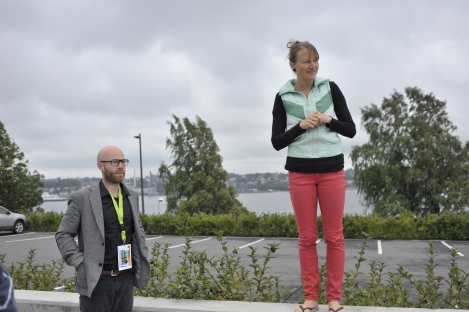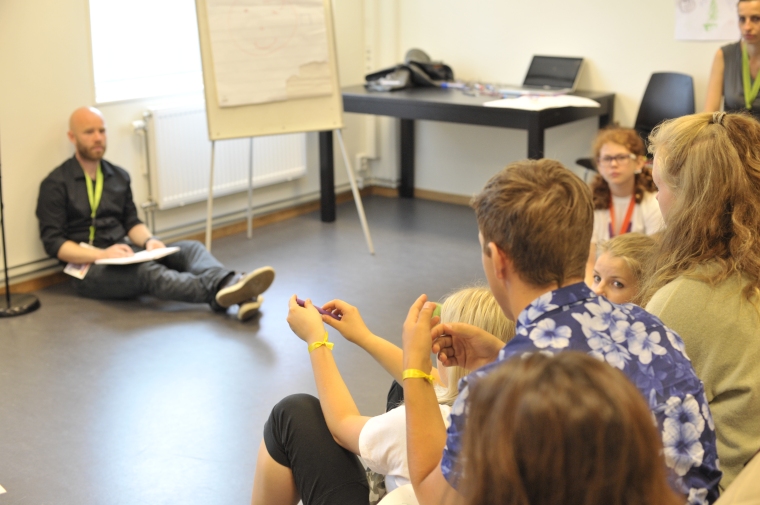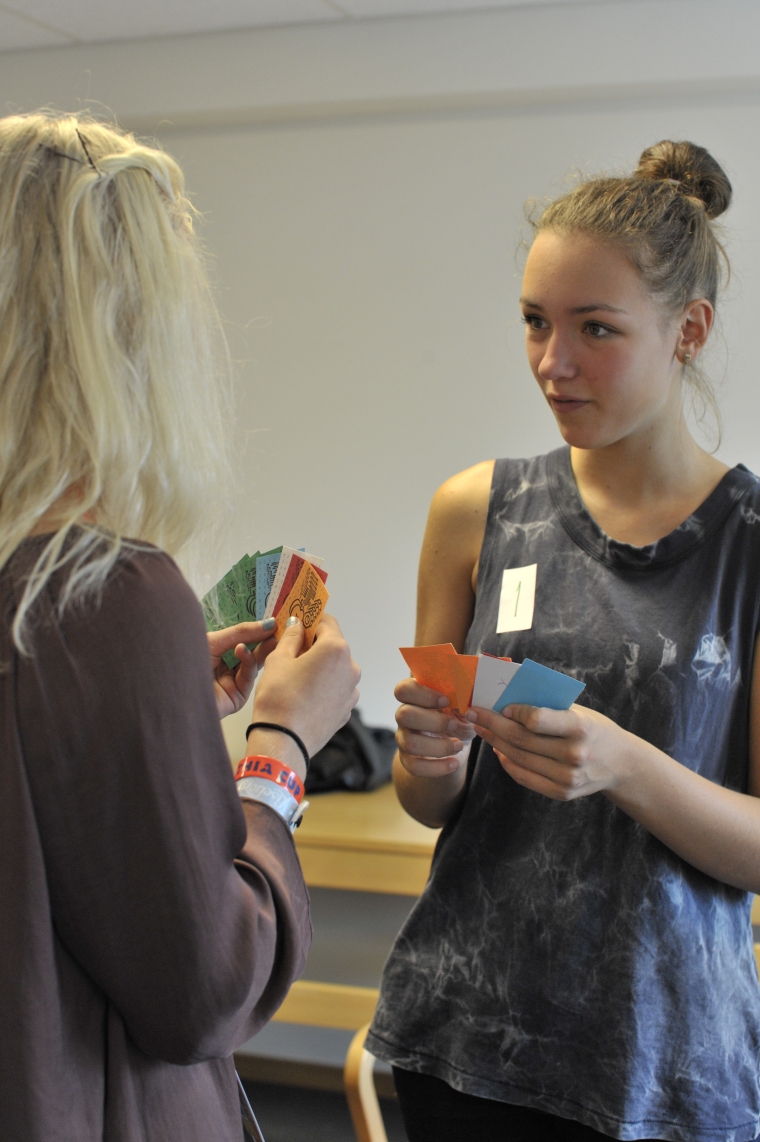If some of you have attended the peace seminar this year and participated to the fabulous bafa bafa workshop, you know a little more about it. but maybe you would like to go deeper and understand more. So here are some more hints about the meanings of this simulation game and what to expect when diving into another culture! (moderated by excellent Mette Juel Madsen and Erik Modin)
BaFa’ BaFa’ is a face-to-face learning simulation. It is intended to improve participants’ cultural competency by helping them understand the impact of culture on the behavior of people and organizations. Participants experience “culture shock” by traveling to and trying to interact with a culture in which the people have different values, different ways of behaving and different ways of solving problems.
BaFa’ BaFa’ is designed to either stand-alone or be incorporated into a firm’s diversity training. The simulation takes about an hour and a half and may have up to thee hundred participants. After the simulation, the debriefing period can last up to four hours.
BaFa’ BaFa’ was invented by Dr. Garry Shirts[1] and is published and marketed by Simulation Training Systems of San Diego, CA. There are three versions, one for schools and universities; one for middle school children called RaFa’ RaFa’ created in the late 70’s; and Professional BaFa’ BaFa’, first published in 1993, tailored to the workplace needs of corporations and government agencies. Professional BaFa’ BaFa’ is available in English, Spanish and Portuguese.
How BaFa’ BaFa’ Works
Two simulated cultures are created: an Alpha culture and a Beta culture. The director briefs the participants on the general purposes of the simulation and then assigns them membership in either the Alpha or Beta culture. Each group moves into its own area where members are taught the values, expectations and customs of their new culture.
Once all of the members understand and feel comfortable with their new culture, each culture sends an observer to the other. The observers attempt to learn as much as possible about the values, norms and customs of the other culture without directly asking questions. After a fixed time, each observer returns to his or her respective culture and reports on what he or she observed.
Based on the report of the observer, each group develops hypotheses about the most effective way to interact with the other culture. After the hypotheses have been formulated, the participants take turns visiting the other culture in small groups. After each visit, the visitors report their observations to their group. The group uses the data to test and improve their hypotheses. When everyone has had a chance to visit the other culture, the simulation ends.
The participants then come together in one group to discuss and analyze their experience. If the purpose of the training is to train a person to interact or travel to a different culture, then the facts of that culture are presented as part of the discussion. If the focus is on diversity, then the discussion and analysis focuses on methods for creating a work culture that allows everyone to feel safe, feel included, be productive, and do their best work. The definition of a culturally competent person then, not only includes the ability to adapt or interact with people who are different, it means being able to design and sustain a work culture that includes everyone and allows each person to do their best work.
History of BaFa’ BaFa’
The decision to homeport the U.S. Navy 6th fleet in Greece in the early 70s caused a great deal of concern and uneasiness in Greece. In the midst of the cold war, the United States believed it was in their interest to support the 1967-74 coup by the Greek military. The decision http://en.wikipedia.org/wiki/Greek_%E2%80%93_United_States_relations angered many Greek citizens.
This uneasiness was exacerbated by an incident in Greece involving two sailors and a merchant that got front-page headlines in the Greek and American press including a column by Robert Novak criticizing the navy for not preparing American Sailors to live in foreign cultures. The incident occurred when two sailors from the sixth fleet discovered they had bought the same trinket from a merchant, but the merchant had charged one sailor much more for his trinket than the other. The sailor who paid the higher price was outraged. He returned to the merchant, accused him of ripping him off and a verbal argument ensued and then a fight. The resulting confrontation became a front page story in the Greek press. The Greek citizens were especially angered by the fact that the American sailors were immune from prosecution. The incident escalated to the point that the Greek government threatened to kick the 6th fleet out of Greece.
Meanwhile the Navy Personnel Research and Development Center in San Diego California had several projects underway to improve the cultural competency of U.S. military personnel assigned to foreign cultures. One of the projects included a study of the in – country experiences by Ted Yellen and Margaret. They concluded that,
“Many of the problems recounted by the navy men could be minimized if they had a better understanding of the Greek social customs and daily living pattern, and had at least a few words and phrases of Greek with which to communicate with host-country nationals.
to help members of a dominant culture value people from other cultures;
to help organizations develop an inclusion culture.
Developing an inclusion culture involves helping members of the dominant culture develop plans, practices and policies that ensure that people who are different consider themselves to be valued members of the dominant culture. When the goal is to ensure that every person, regardless of differences, is able to feel included and to do his or her best work in the organization, a separate set of discussion and analysis questions is included along with suggestions for creating an inclusion culture.
The external references include a link to about 200 references describing different ways BaFa’ BaFa’ has been used.
BaFa’ BaFa’ In Diversity Training
As diversity training has evolved in recent years, BaFa’ BaFa’ has been used by some organizations to make diversity training more effective. Historically, diversity programs have taken one of three different approaches:
1. COMPLIANCE
This approach emphasized compliance with the legal requirements of various sections of EEO type legislation. It was based on the assumption that African Americans and other minority groups had been unfairly excluded from the workplace. The EEO legislation was designed to correct that situation.
Training often focused on helping companies develop detailed plans and strategies for meeting the demands of the legislation. Fear of being sued was the main motivating force behind the development of these programs. Rarely did they generate much positive energy.
This approach often created resistance in the workplace as well. Some employers complained that, (1) they were being made to pay for sins they did not commit and, (2) they believed compliance only benefited the people who were hired and provided no benefit to the company.
Many minorities who were hired under this plan were not accepted in the workplace once they were hired. They often felt that they had to work twice as hard as everyone else to prove that they were not hired because of their race.
2. THE “MORAL IMPERATIVE” APPROACH
With this approach, the emphasis was much more positive. It tried to get people to understand that everyone should be valued and accepted for what they are because it is the
right thing to do.
The training programs often emphasized the ethical values of fairness and inclusion. They often tried to use guilt as a way of motivating people to action. Such programs focused on trying to get the participants to understand and feel the painful and debilitating effects of discrimination. Others tried to show how those in power had abused their power and were insensitive to those who were out of power. When this approach was taken to its extreme, it was sometimes characterized as “white male” bashing.
These programs often emphasized the differences among groups as a way of trying to get people to accept one another for what they are. They then tried to define the main characteristics of different racial and cultural groups: African Americans are this way, Asians are this way, etc. The net affect of emphasizing differences, without pointing out that the differences developed because people were trying to solve common problems, often had just the opposite effect of what was intended. Instead of creating acceptance and understanding, they often created distance and misunderstanding between groups of people. “Oh, they are different, so I have nothing in common with them.”
3. THE “ADDED VALUE” APPROACH.
The added value or bottom line approach has as its basic assumption that the reason differences develop in cultures is because people have developed different solutions to common problems. The types of common problems that people are trying to solve are reflected in such questions as: “How do we survive?” “How do we get our basic needs met?” “How does a person get his or her feelings of self-worth in this culture?” “How can we ensure that our progenitors will have their basic needs met?” “How do we communicate?” “How do we deal with inequality in status?” “How do we satisfy the urges we have for self-expression and affiliation?”
With this approach, our differences become gateways to understanding our common humanity: It encourages a different kind of reasoning; “Oh, you were faced with that same problem, so were we. Here’s how we solved it, how did you solve it?” Not only do our differences reflect different solutions to common problems; they often reflect different approaches to solving problems. Some cultural groups, for example, tend to solve problems in a very sequential, ordered way. Other cultures tend to be more iterative, or more sensitive to the context of the problem. When these different approaches to solving problems are brought into an organization, it increases the probability that the optimal solution will be found.
When we look at it this way, we begin to realize that bringing people from different cultures, backgrounds, and races into the organization is like bringing a whole different set of solutions and ways of solving problems to the work culture. If done properly it can create energy, enrich the decision making process, and increase the probability that good decisions will be made. One values diversity not because the law says we should, not even because it’s the approach we “ought to” take (although that is true as well). We value it because it adds value to the work culture and improves the bottom line.
With this approach, it is important that an organization realizes that it is a culture in and of itself. It is a culture that is different than all the cultures of its employees. If it is to be successful, the leaders must create a work culture that encourages all of these different solutions and approaches to problems to be expressed. Once this type of culture is created, then the only caveat that is required is that these different solutions and approaches must be consistent with the organization’s goals and values.
It is also important that they realize that everyone is bicultural. When people return to their home culture during their off hours, they often get refueled and it ensures that their ability to look at problems with fresh eyes and fresh approaches will be maintained.
BaFa’ BaFa’ takes the value added approach. The basic assumption is that creating a culturally diverse work force greatly enhances the value of the work culture.
By R. Garry Shirts
Cited References
1. Shirts, R. Garry, (Oct 1992) “Ten Secrets of Successful Simulations”, Training, 79-81.
2. Yellen, Ted M. I. and Hoover, Margaret (1973), “In Country Experiences: Navy Personnel Stationed In Greece, Special Report, Navy Personnel Research Laboratory, Washington, D.C.“




Hello. My name is Mitch, I’m with the company that designed and publishes the BaFa’ BaFa’ game. I love this photo of the students trading, would it be possible to use it on our website? Please let me know. Sincerely,
Mitch Shirts
hello dear Mitch
Yes no problem to use them. If you could mention Barnasfredsverden as a copyright it would be just great! 🙂 best wishes. Patricia